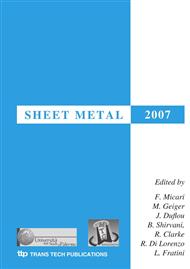[1]
T.S. Kwak, Y.J. Kim and W.E. Bae: Finite element analysis on the effect of die clearance on shear planes in fine blanking. Journal of Materials Processing Technology 130-131 (2002), pp.462-468.
DOI: 10.1016/s0924-0136(02)00767-7
Google Scholar
[2]
T.C. Lee, L.C. Chan, B.J. Wu: Straining behaviour in blanking process - fine blanking vs. conventional blanking. Journal of Materials Processing Technology 48 (1995), pp.105-111.
DOI: 10.1016/0924-0136(94)01639-i
Google Scholar
[3]
Dae-Cheol Ko and Byung-Min Kim: Development of an analytical scheme to predict the need for tool regrinding in shearing processes. International Journal of Machine Tools & Manufacture 40 (2000), pp.1329-1349.
DOI: 10.1016/s0890-6955(99)00125-x
Google Scholar
[4]
F. Faura, A. Gracia and M. Estrems: Finite element analysis of optimum clearance in the banking process. Journal of Materials Processing Technology 80-81 (1998), pp.121-125.
DOI: 10.1016/s0924-0136(98)00181-2
Google Scholar
[5]
R. Hambli and F. Guerin: Application of a neural network for optimum clearance prediction in sheet metal blanking process. Finite Elements in Analysis and Design 39 (2003), pp.1039-1052.
DOI: 10.1016/s0168-874x(02)00155-5
Google Scholar
[6]
S.K. Maiti, A.A. Ambekar, U.P. Singh, P.P. Date and K. Narasimhan: Assessment of influence of some process parameters on sheet metal blanking. Journal of Materials Processing Technology 102 (2000), pp.249-256.
DOI: 10.1016/s0924-0136(99)00486-0
Google Scholar
[7]
Miguel Vaz Jr. and Jose Divo Bressan: A computational approach to blanking process. Journal of Materials Processing Technology, 125-126 (2002), pp.206-212.
DOI: 10.1016/s0924-0136(02)00313-8
Google Scholar
[8]
A.M. Goijaerts, Y.W. Stegeman, L.E. Govaert, D. Brokken, W.A.M. Brekelmans and F.P.T. Baaijens: Can a new experimental and numerical study improve metal blanking? Journal of Materials Processing Technology 103 (2000), pp.44-50.
DOI: 10.1016/s0924-0136(00)00417-9
Google Scholar
[9]
N. Hatanaka, K. Yamaguchi and N. Takakura: Finite element simulation of the shearing mechanism in the banking of sweet metal. Journal of Materials Processing Technology 139 (2003), pp.64-70.
DOI: 10.1016/s0924-0136(03)00183-3
Google Scholar
[10]
S.S. Kim, C.S. Han and Y-S. Lee: Development of a new burr-free hydro-mechanical punching. Journal of Materials Processing Technology 162-163 (2005), pp.524-529.
DOI: 10.1016/j.jmatprotec.2005.02.110
Google Scholar
[11]
R. Melechov, K. Tubielewicz, W. Błaszczuk: Titanium and its alloys (Tytan i jego stopy). Edited by Częstochowa University of Technology, Częstochowa - Poland, (2004).
Google Scholar
[12]
ADINA System v. 8. 3. Theory and Modeling Guide, vol. I: ADINA Solids & Structures. ADINA R&D, Inc., (2005).
Google Scholar


